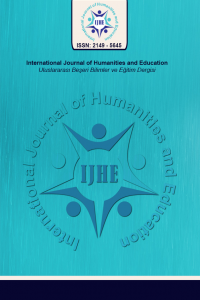Using Games To Teach Spanish As A Foreign Language In One-On-One Sessions With Young Learners
oyunlar, öğretim stratejileri, özel ders, Türkiye, yabanci dil olarak ispanyolca
___
- Al-Bulushi, A. H., & Al-Issa, A. (2017). Playing with the Language: Investigating the Role of Communicative Games in an Arab Language Teaching System. International Journal of Instruction, 10(2), 179-198.
- Asensio Pastor, M. (2016). Enseñar español como lengua extranjera a niños: aportaciones teórico-prácticas [Teach Spanish as a foreign language to children: theoretical and practical contributions]. Lenguaje y Textos, 0(44), 95-105.
- Bray, M., & Kwo, O. (2014). Regulating Private Tutoring for Public Good: Policy Options for Supplementary Education in Asia. Hong Kong, China: The University of Hong Kong, Comparative Education Research Centre.
- Buchmann, C., Condron, D., & Roscigno, V. (2010). Shadow Education, American Style: Test Preparation, the SAT and College Enrollment. Social Forces, 89(2), 435–461.
- Chui, M. (2016). Private supplementary Tutoring: motivations and effects: a review study. Journal of Education and Practice, 7(27), 195-198.
- Creswell, J. W. (2012). Educational Research: planning, conducting, and evaluating quantitative and qualitative research (4th ed.). Boston, MA: Pearson Education, Inc.
- Fernández Vítores, D. (2018). El español: una lengua viva. Informe 2018 [Spanish: a living language.2018 Report]. Instituto Cervantes. Madrid: Retrieved from https://cvc.cervantes.es/lengua/espanol_lengua_viva/pdf/espanol_lengua_viva_2018.pdf.
- Hajar, A. (2018). Exploring Year 6 pupils’ perceptions of private tutoring: evidence from three mainstream schools in England. Oxford Review of Education, 44(4), 514-531.
- Hanghøj, T. (2013). Game-Based Teaching: Practices, Roles, and Pedagogies. En S. d. Freitas, M. Ott, M. Popescu, & I. Stanescu, New Pedagogical Approaches in Game Enhanced Learning: Curriculum Integration (págs. 81-101). Hershey, PA, United States of America: IGI Global.
- Harrison, H., Birks, M., Franklin, R., & Mills, J. (January de 2017). Case Study Research: Foundations and Methodological Orientations. Forum Qualitative Sozialforschung / Forum: Qualitative Social Research, 18(1).
- Kangas, M., Koskinen, A., & Krokfors, L. (2017). A qualitative literature review of educational games in the classroom: the teacher’s pedagogical activities. Teachers and Teaching: Theory and Practice, 23(4), 451-470.
- Kirriemuir, J., & Mcfarlane, A. (2004). Literature Review in Games and Learning. Bristol, UK: Nesta Futurelab.
- Lewis-Moreno, B. (2002). Instructional Strategies for ESL Students Checklist. Retrieved from http://saisd.net/admin/curric/bilingual/.
- Marklund, B. B., & Alklind Taylor, A.-S. (2016). Educational Games in Practice: The challenges involved in conducting a game-based curriculum. The Electronic Journal of e-Learning, 14(2), 122-135.
- Mayda, A. (2015). Effective Instructional Strategies for English Language Learners . Ontario Institute for Studies in Education of the University of Toronto. Toronto: Retrieved from https://tspace.library.utoronto.ca/bitstream/1807/68786/1/Mayda_Asiye_201506_MT_MTRP.pdf.
- Navarro Carrascosa, C. (2017). Enseñar español en Turquía: La enseñanza de ELE entre Oriente y Occidente [Teaching Spanish in Turkey: Teaching Spanish as a Foreign Language between East and West]. En M. Méndez Santos, & M. Galindo Merino, Atlas de ELE. Geolingüística del español en el mundo. Volumen I. Europa oriental (págs. 411-426). Madrid: EnClaveELE.
- Sardone, N. B., & Devlin-Scherer, R. (2016). Let the (Board) Games Begin: Creative Ways to Enhance Teaching and Learning. The Clearing House: A Journal of Educational Strategies, Issues and Ideas, 89(6), 215 - 222.
- Şener, S., & Çokçalışkan, A. (2018). An Investigation between Multiple Intelligences and Learning Styles. Journal of Education and Training Studies, 6(2), 125-132.
- Seymour, D., & Popova, M. (2003). 700 Classroom activities. Oxford, England: Macmillan.
- Šťastný, V. (2017). Private tutoring lessons supply: insights from online advertising in the Czech Republic. Compare: A Journal of Comparative and International Education, 47(4), 561-579.
- Subedi, K. (2018). Shadow Education: A Role of Private Tutoring in Learning. International Journal of Humanities and Social Sciences, 1(2), 29-42.
- Yin, R. K. (2016). Qualitative Research from Start to Finish (Second ed.). New York, NY: The Guilford Press.
- Zirawaga, V. S., Olusanya, A. I., & Maduku, T. (2017). Gaming in Education: Using Games as a Support Tool to Teach History. Journal of Education and Practice, 8(15), 55 - 64.
- Başlangıç: 2015
- Yayıncı: Halil TURGUT
Elmalılı Hamdi Yazır’ın Kur’an Tefsiri Çerçevesinde Lisanın Toplumsal Dönüşümdeki İşlevi
Uğur Berk KALELİOĞLU, Menderes SOYDAN
Tilim Han Divanı (Orta İran Türk Ağzı): Giriş-İnceleme Metin -Dizin
KÜRESELLEŞME VE TEKNOLOJİ ÜZERİNE BİR DEĞERLENDİRME
ANADOLU SELÇUKLU DÖNEMİ MİMARİ YAPILARINDA TURKUAZ
Cinsel İstismarın Önlenmesinde Cinsel Eğitimin Önemi
Nural İMİK TANYILDIZI, Ayşe Şebnem YOLCU
Uluslararası Askerî Örgütlerdeki Kültürel Farklılıkların Liderlik Üzerindeki Etkileri
